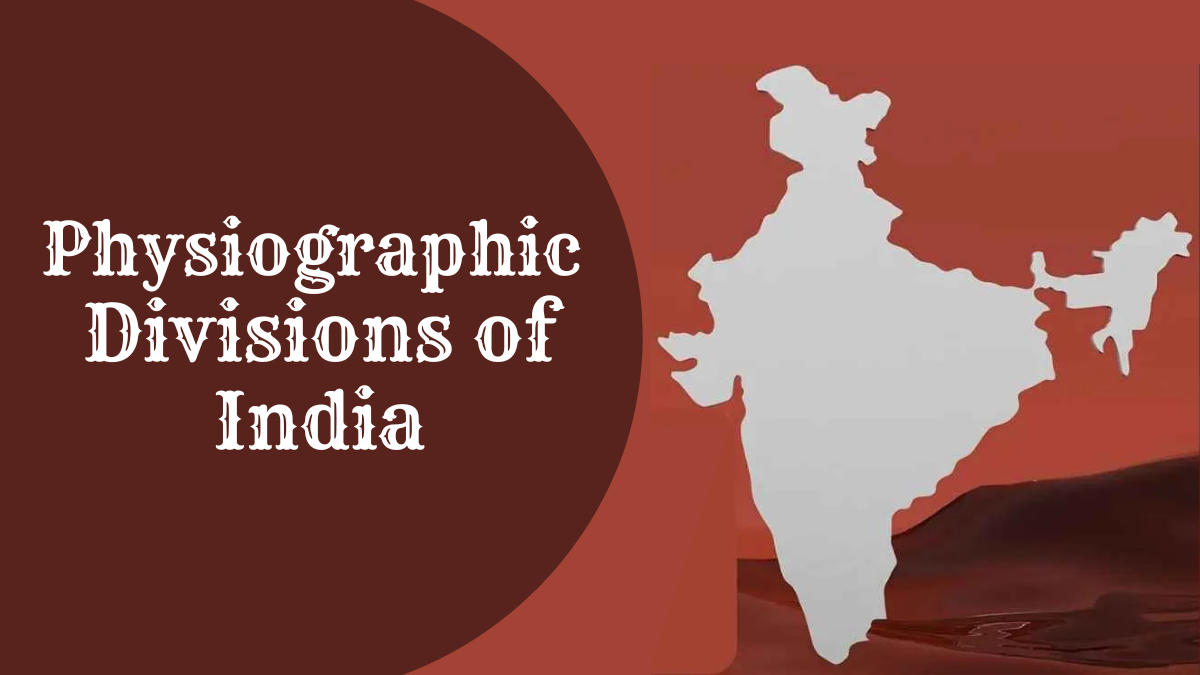Physiographic Divisions of India
India is situated north of the equator between 8°4′ north (the mainland) and 37°6′ north latitude, and between 68°7′ east and 97°25′ east longitude. India is the seventh-largest country in the world with a total area of 3,287,263 square kilometres. India is 3,214 km (1,997 mi) long from north to south and 2,933 km (1,822 mi) long from east to west. Its land boundary is 15,200 kilometres (9,445 miles) long, and its coastline is 7,516.6 kilometres long (4,671 mi).
What is Physiography?- Physiography of India
An area’s physiography results from its structure, processes, and developmental stage. The physical characteristics of India’s terrain are extremely diverse. The north contains a huge area of rough landscape made up of numerous mountain ranges with a variety of peak shapes, lovely valleys, and deep canyons. The south is made up of stable table terrain with deeply cut plateaus, bare rocks, and extensive scarp systems. The enormous north Indian plain is located between these two.
Physiographic Divisions of India: Geography of India
- Essentially defining India’s northern borders is the Himalayan mountain range, which it shares with China, Bhutan, and Nepal.
- Its western boundary with Pakistan is formed by the Western and Karakoram Himalayan peaks, the Punjab Plains, the Thar Desert, and the Rann of Kutch salt marshes.
- The Chin Hills and Kachin Hills, two highly forested mountain ranges in the far northeast, separate India and Burma.
- The watershed region of the Indo-Gangetic Plain, the Khasi and Mizo Hills, and Bangladesh’s eastern border all significantly contribute to the definition of this country’s eastern border.
- The Ganges is the longest river to have its source in India.
- The Ganges-Brahmaputra system covers most of northern, central, and eastern India, whilst the Deccan Plateau dominates southern India.
- Kangchenjunga, the third-highest peak in the world, is 8,586 m (28,169 ft) above sea level and is situated in the Indian state of Sikkim.
- The extreme southern region of India has an equatorial climate, whereas the upper Himalayan highlands have an alpine and tundra environment.
- The Indian Plate, which is a section of the Indo-Australian Plate in the north, is where India is situated.
Physiographic Divisions of India: The Northern Mountains
- The Himalayas are the result of the Indian and Eurasian plates colliding. Indian Peninsula split off from Gondwana during the Cretaceous Period and began moving north. Between the two plates, the Tethys was squeezed, creating a geosyncline.
- Part of these rocks are still present in the Ladakh region because of the subduction of the Indian Plate’s oceanic margin as the plate migrated north.
- Eastern Himalayas were generated by the collision of the Indian and Eurasian plates 60 million years ago, which caused the construction of the Potwar plateau and an anticlockwise spin in the plate.
- Further northward drift and further Tethys sea compression caused the Tethian Himalayas to rise.
- Mountains continued to converge, creating fold mountains known as the Main Himalayas or Greater Himalayas, and south of them, the Main Central Thrust.
- The Main Boundary Fault line was formed south of the Lesser Himalayas, sometimes known as the Middle Himalayas, as the process progressed.
- Foredeep was formed on the foothills of the Greater and Lesser Himalayas, where deposition and subsequent compression resulted in the construction of the Shivalik Mountains. A new fault line that occurred south of it is known as the Himalayan Frontal Fault.
- The Indus Tsangpo Suture zone refers to the location where two plates are converging.
- These young Himalayas continue to increase in height as a result of isostatic changes.
Following are the classification of Himalayas:
- Trans Himalayas
- Indus Tsangpo Suture zone
- Tethian Himalayas
- Main Himalayas
- Lesser Himalayas
- Shiwaliks
Physiographic Divisions of India: The Northern Plain
- The result of alluvial deposits transported by rivers with their origins in the Himalayan and Peninsular areas are the great plains.
- In total, these plains cover a distance of 3,200 kilometres from east to west.
- The relief features of the Great Plains are extremely consistent over distances of hundreds of kilometres.
- Blowing up the monotony are cliffs, levees, ravines, and khols.
Following are the divisions of Northern Plains:
- Bhabar plains
- Tarai plains
- Bhangar Plains
- Khadar Plains
- Delta plains
Physiographic Divisions of India: The Peninsular Plateau
- The Peninsular plateau is an irregular triangle with an elevation range of 600–900 m, rising from a height of 150 m above the river flats.
- The Peninsular plateau’s outside boundaries are defined by the Delhi Ridge in the northwest (an extension of the Aravalis), the Rajmahal Hills in the east, the Gir Range in the west, and the Cardamom Hills in the south.
- However, the Shillong and Karbi-Anglong plateau in the northeast serve as an extension of this.
- Peninsular India is made up of a number of patland plateaus, including the Karnataka plateau, the Hazaribagh plateau, the Palamu plateau, the Ranchi plateau, the Malwa plateau, and others.
- One of India’s oldest and most stable landmasses is this one.
- The pattern of river flow further supports the plateau’s general height, which runs from the west to the east.
- Tors, block mountains, rift valleys, spurs, bare rocky structures, a sequence of humpbacked hills, and wall-like quartzite dykes that provide natural places for water storage are some of the significant physiographic features of this area.
- Black dirt is conspicuously present in the plateau’s western and northern regions.
The crustal faulting and fractures that are present on this Peninsular plateau are the result of several episodes of uplift and submergence. Due to its frequent seismic activity, the Bhima fault deserves special attention. The Peninsular plateau’s relief has undergone some variability as a result of these geographical changes. The plateau’s northwest features a difficult terrain made up of canyons and ravines. Examples of well-known ravines are those in Chambal, Bhind, and Morena.
Following are the divisions of Peninsular Plateau of India:
- Deccan trap
- The Deccan Plateau
- Malwa Plateau
- Bundelkhand
- Chota Nagpur Plateau
- The Northeastern Plateau
- Telangana Plateau
- Karnataka Plateau
- Dandakaranya
- Vindhya Range
- Satpura Range
- Western Ghats
- Eastern Ghats
Physiographic Divisions of India: Islands of India
- India has two significant island groups: one in the Arabian Sea and one in the Bay of Bengal.
- There are approximately 572 islands and islets in the Bay of Bengal island groups. They are basically located between 6°N and 14°N and 92°E and 94°E.
- The Ritchie’s archipelago and Labrynth island are the two main islet groups.
- The Andaman in the north and the Nicobar in the south make up the two main divisions of the entire group of islands.
- A body of water known as the Ten Degree Channel separates them. These islands are thought to be an elevated section of underwater mountains.
- Some smaller islands, though, were formed by volcanic activity. The Nicobar Islands also contain the only active volcano in India, a barren island.
- Beautiful beaches and some coral deposits can be seen along the coast. These islands have equatorial-style vegetation and receive convectional rainfall.
- The Lakshadweep and Minicoy islands are located in the Arabian Sea. These are dispersed between latitudes 8°N and 12°N and 71°E and 74°E. These islands are situated between 280 and 480 kilometres off the coast of Kerala.
- The entire island chain is made of deposits of coral. There are about 36 islands total, and 11 of them are populated.
- The largest island, Minicoy, has a surface area of 453 sq. km.
- The Ten Degree Channel, to the north of which is the Amini Island and to the south of which is the Cannanore Island, roughly divides the entire collection of islands.
- On their eastern seaboard, the islands of this archipelago have storm beaches made of loose pebbles, shingles, cobbles, and boulders.
Following are the Islands of India:
1. Islands of India: Andaman Islands
The Andaman Islands are a group of islands in the northeastern Indian Ocean, 130 km southwest of the Ayeyarwady Region of Myanmar. The Andaman Islands act as a maritime border between the Andaman Sea and the Bay of Bengal to the east, along with the Nicobar Islands to their south. The majority of the islands are a part of Myanmar’s Yangon Region, while the Coco Islands and Preparis Island are a part of India’s Union Territory of the Andaman and Nicobar Islands.
The Andamanese are a diverse collection of indigenous people that live in the Andaman Islands, including the Jarawa and Sentinelese tribes. While some of the islands can be visited with a permit, North Sentinel Island is one among those where entry is prohibited by law. The Sentinelese have minimal interaction with other people and are typically hostile to outsiders. Their right to privacy is safeguarded by the government.
2. Islands of India: Nicobar Islands
In the eastern Indian Ocean, there is an archipelago of islands known as the Nicobar Islands. They are situated in Southeast Asia 150 kilometres (miles) northwest of Aceh in Sumatra, and the Andaman Sea divides them from Thailand to the east. They are a part of India as the Nicobar district within the union territory of the Andaman and Nicobar Islands, which located 1,300 kilometres southeast of the Indian subcontinent across the Bay of Bengal.
The Great Nicobar Island has been designated as one of the World Network of Biosphere Reserves by UNESCO.
3. Islands of India: Lakshadweep Islands
Off the coast of Kerala, India, in the Laccadive Sea, is the tropical archipelago of Lakshadweep, which consists of 36 atolls and coral reefs. Only a few of the islands are accessible to tourists and not all of them are inhabited (permits required). The ornately painted Ujra Mosque is just one of the several mosques on Kavaratti, one of the more developed islands. The aquarium on the island also features local fish, shark, and coral species.
4. Islands of India: Daman and Diu Islands
Northwestern India’s Daman and Diu was formerly a union territory. It was the smallest administrative division of India on the mainland, with only 112 km2 (43 sq mi). The Gulf of Khambat divided the two districts that made up the region, Damaon and Dio island. The Arabian Sea and the Gujarat state bordered the region. Goa was Portuguese colony since the 1500s, the areas were annexed by India in 1961.
Between 1961 to 1987, Daman and Diu were governed as a part of the Goa Union Territory; however, after the Goa Opinion Poll, they were given separate union territory status. To create the new union territory of Dadra and Nagar Haveli and Daman and Diu, which would take effect on January 26, 2020, legislation to unite the union territories of Daman and Diu and its neighbouring union territory, Dadra and Nagar Haveli, was enacted in 2019.
5. Islands of India: Puducherry Islands
The Indian union territory of Puducherry, often spelled Pondicherry or Pondichéry, is made up of four interconnected minor districts. It was created from four former French Indian territories: Pondichery, Karikal (Karaikal), Mahé, and Yanaon (now Yanam), excluding Chandannagar (Chandernagore), and it was given the name Puducherry after the largest district, which was also the old French Indian capital. Previously known as Pondicherry, the region’s official name was changed to Puducherry on September 20, 2006.
In the southernmost region of the Indian Peninsula is the Union Territory of Puducherry. Yanam district and Mahe district are respectively bordered by the states of Andhra Pradesh and Kerala, while Puducherry district and Karaikal district are bounded by the state of Tamil Nadu. Of India’s 36 states and union territories, Puducherry has the 29th largest population and is the third most densely populated.
Physiographic Divisions of India: Coastal Plains of India
A coastal plain is a flat, low-lying area of land close to the sea. The boundary between a coastal plain and a piedmont region is frequently marked by a fall line. Along India’s western and eastern shores, on either side of the Deccan Plateau, are the Coastal Plains. From the Rann of Kutch in the west to West Bengal in the east, they span a distance of around 6,150 kilometres. The Western Coastal Plains and the Eastern Coastal Plains are the two main divisions. At Kanyakumari, the southernmost point of the Indian mainland, the two coastal plains converge. Between the Bay of Bengal and the eastern Ghats is where you’ll find the eastern coastal plain, while between the Arabian Sea and the western Ghats is where you’ll find the western coastal plain.
Following are the Coastal plains of India:
1. Coastal Plains of India: Gujarat Plains
Gujarat Plains is a huge expanse of plains in the western Indian state of Gujarat. The plains are roughly 12,800 square miles (33,000 square kilometres) in size and are bordered to the north by the Rajasthani state’s desert edge, to the east by the hills of eastern Gujarat, to the south by the Arabian Sea, and to the west by the Kathiawar Peninsula. The area has an average elevation of around 80 feet and is a projection of the alluvial Sindhu-Ganges Plains, which slope from north to south (25 metres).
2. Coastal Plains of India: Konkan Plains
Thane, Greater Mumbai, Raigarh, and Ratnagiri are all parts of the Konkan, which has a width of between 28 and 47 miles (45 and 76 kilometres). Seasonal rivers that flow through the area empty the Sahyadri Hills’ summit of heavy monsoonal rain.
3. Coastal Plains of India: Kanara Plain
Kanara has a surface area of around 10,000 square kilometres (4,000 square miles). It is bordered to the north by the Konkan, to the east by the Western Ghats, to the east by the Kerala Plains, and to the south by the Arabian Sea.
4. Coastal Plains of India: Malabar Plains
The area is a part of The Malabar Coast, which historically refers to the southwest coast of India and is located on a slender coastal plain shared by the states of Karnataka and Kerala between the Western Ghats mountain range and the Arabian Sea. South of Goa to Cape Comorin, which is the southernmost point of India, is along the coast.
5. Coastal Plains of India: Coromandel Coast
The Coromandel Coast, which covers an area of roughly 22,800 square kilometres and is located in the southeast of the Indian subcontinent, is bordered by the Utkal Plains to the north, the Bay of Bengal to the east, the Kaveri delta to the south, and the Eastern Ghats to the west.
6. Coastal Plains of India: Andhra Coast
Kostha Andhra, sometimes referred to as the coastal Andhra Pradesh, is a region in the Indian state of Andhra Pradesh. The main city in this region is Visakhapatnam, while the second largest is Vijayawada. Prior to 1953 and between 1953 and 1956, it was a part of Madras State.
7. Coastal Plains of India: Utkal Coast
The East Coastal Plain of India includes the Utkal Plain. It is a coastal plain in the eastern Indian state of Odisha. It contains the Mahanadi River, Brahmani River, and Baitarani River deltas. The Chilka Lake is the most notable physiographic feature of this plain.









 Try CUET College Predictor 2025 to Predi...
Try CUET College Predictor 2025 to Predi...
 CUET Result 2025 OUT (Today) @cuet.nta.n...
CUET Result 2025 OUT (Today) @cuet.nta.n...
 Why the Delay in CUET UG 2025 Results? C...
Why the Delay in CUET UG 2025 Results? C...









